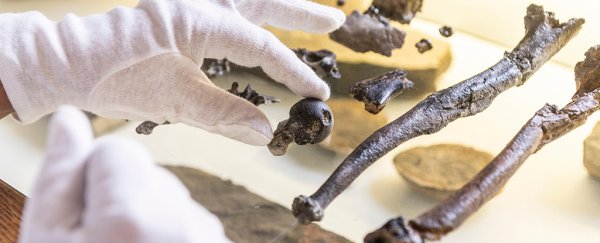The fact we can confidently balance on top of a pair of meat-sticks without toppling over is the very symbol of human evolution. Yet just how we came to stand upright in the first place remains a hotly debated topic.
Now we have a new piece in the puzzle. Recently discovered fossils left by a relative who lived during the Miocene some 11.6 million years ago has provided compelling new evidence that our journey onto open ground could be compared to a toddler learning to walk, rather than a baby rising from a crawl.
Thanks to an assortment of well-preserved hominid bones uncovered from a German dig site in recent years, an international team of researchers has had a rare look at the bodies of ancient relatives who were yet to leave the safety of the forest canopy.
Most ancient primate bones we uncover tend to be small or heavily fragmented, leaving us to fill in the blanks by making comparisons and guesswork.
Since limbs and pelvises are some of the hardest body parts to come by, determining how we went from squatting in branches to being able to waltz has been a bit of a challenge. One of the big questions is whether humans crawled or walked on palms and knuckles before they rose up to stand.
Luckily for us, this trove of old-school specimens include a bonanza of jaw bones, femurs, vertebrae, and foot bones from a male, a juvenile, and two females of an ape-like species researchers have dubbed Danuvius guggenmosi.
Putting the jigsaw together reveals an animal with body proportions that wouldn't look weird on a chimpanzee, only with slightly less robust hands, more similar to those of an orangutan.
For the most part, Danuvius resembled another primate of the Miocene called Dryopithecus, but it's the variety of previously unseen features that have palaeontologists excited.
For at least 4 to 5 million years, humans and their rag-tag collective of now-extinct close cousins have been strictly bipedal, with hind-limbs perfectly suited for acting as pendulums that swing back and forth with each stride.
Some of those relatives have hinted our departure from a life among the trees was anything but a clean break, but it's been difficult tracing a clear evolutionary pathway from gripping tree limbs with our feet to planting them solidly on the ground.
Some experts are fairly confident that our first tentative steps relied on palmigrade locomotion, with our palms and soles pressed to the soil as we loped or scrambled from place to place.
Others think the evolution of human bipedalism was far more gradual, with our ancestors retaining a firm grip on the surrounding vegetation much as chimpanzees do today, holding ourselves steady until needs drove us to step further and further away.
Danuvius's bones point more towards that second hypothesis, but with a slight difference, indicating process called extended limb clambering.
A close look at Danuvius's hands reveals bones that simply wouldn't have been robust enough for a slumped, gorilla-like knuckle walk.
But there are also clear signs it still could have used its arms to hang suspended from the branches, similar to chimps.
The big difference is that it had a pair of comparably strong legs steadily keeping its body upright by pressing up from the ground, instead of just using its arms to hang.
What makes this particular form of suspensory movement stand out is a reliance on both sets of limbs to hold balance, showing no particular preference for pulling itself up with its arms or pushing itself along with its legs.
The picture we get is of a dangling hominid tentatively holding on like a child gripping its parent's fingers, moving like a toddler through the forest shade rather than pushing itself up from a four-limbed crawl on palms or knuckles.
Of course those first steps were just the first in a series of adaptations, each a solution in its own way to environmental changes that favoured one form of motion over another.
Our story is still far from complete. Hopefully there are still plenty of clues left to be uncovered in the bones of our ancestors, that will one day give us a more complete understanding of how humans became such upstanding apes.
This research was published in Nature.
